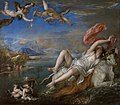Diana and Actaeon (Titian)

|
| Diana and Actaeon |
|---|
| Titian , 1556-1559 |
| Oil on canvas |
| 184.5 x 202.2 cm |
| National Gallery, London ; Scottish National Gallery |
Diana and Actaeon , also called Actaeon Surprising Diana (Artemis) in the bath , is a picture from the series of eight mythological pictures called Poetry , which Titian painted for Philip II of Spain . It depicts the fateful encounter between the hunter Actaeon and the goddess Diana . The picture was completed between 1556 and 1559. It is one of the best-known and most expensive works by Titian.
myth
Aktaion (Actaeon), an obsessed hunter, overhears the goddess Diana , who is bathing in a spring with her nymphs . He is transformed into a deer by the angry goddess and mangled by his own dogs, who no longer recognize him.
From the Metamorphoses of Ovid :
“ But when he entered the grotto, which was
trickled by the spring, the nymphs, naked as they were, shied
their breasts at the sight of the man and filled
the grove with loud, terrified screams and gathered around the goddess Diana
to cover them with their own bodies . But taller in stature,
the goddess towered over them all with her neck . "
history
The eight-part cycle of poetry was created by Titian during his stay at the Spanish court in Madrid between 1553 and 1562 for King Philip II. It is not known under what circumstances the pictures were taken and who selected the subject matter. Today the pictures are spread over several museums.
The first picture was Danaë and the Laburnum , followed by Venus and Adonis , Diana and Callisto , Jason and Medea , Perseus and Andromeda , Diana and Actaeon , The Death of Actaeon and finally Europe and the Taurus . The pictures differ considerably in size and composition. What they have in common is the reference to Ovid's Metamorphoses, with the exception of Jason and Medea and Perseus and Andromeda, all of the pictures deal with the love affairs of Olympic gods .
The paintings remained in the Royal Collection in Madrid until 1704. In 1704, King Philip V , a Bourbone on the Spanish throne, presented the series to the French ambassador, who passed it on to Louis-Philippe, Duke of Orléans . In 1791, two years before his guillotine death , the Duke sold his collection to an art dealer in Brussels. He organized exhibitions in London in which he also offered pictures by Titian. There the British canal builder and coal magnate Francis Egerton , 3rd Duke of Bridgewater, one of the richest men in England, bought the picture, along with the accompanying picture of Tizian Diana and Callisto .
Egerton died childless and part of his fortune, including the Bridgewater Collection, went to his nephew George Gower . He brought the collection of around 70 pictures to his London home, Bridgewater House in Westminster. From 1803 the picture gallery was open to selected visitors in the summer months, e. B. on the recommendation of the Royal Academy of Arts to visit. When the Second World War broke out in 1939, the collection was relocated to Scotland. In 2000, another descendant of Francis Egerton, Francis Egerton, 7th Duke of Sutherland (* 1940), inherited the collection.
From 1945 to 2009 the paintings were on loan from the Scottish National Gallery in Edinburgh. In 2009 the painting Diana and Actaeon was offered by Francis Egerton, as well as Titian's Diana and Callisto , to various museums in Great Britain at a price of 100 million pounds. The painting was jointly acquired by the National Gallery in London and the Scottish National Gallery in Edinburgh for £ 50 million from the collection of the 7th Duke of Egerton in 2009 following a national fundraising campaign in Great Britain . It is now shown alternately in the two museums every five years. In 2012, the two museums acquired the accompanying Diana and Callisto painting from the same owner for £ 45 million.
literature
- Ellis Kirkham Waterhouse: Titian's Diana and Actaeon. Oxford University Press, London et al. 1952.
- Lars Skarsgard: Research and reasoning. A case study on an historical inquiry: “Titian's Diana and Actaeon: A study in artistic innovation”. Akademiförlaget, Gothenburg 1968.
- Marie Tanner: Chance and coincidence in Titian's Diana and Actaeon. In: The Art Bulletin. Vol. 56, 1974, pp. 535-550.
Web links
- Heidi Bürklin: Drama about "the two most beautiful paintings in the world" . In: Die Welt , December 20, 2008.
- Funds secured for Titian painting, BBC News, February 2, 2009
Individual evidence
- ↑ Ovid, Metamorphosen 3, 135-250. On the myth of Herbert Hunger : Lexicon of Greek and Roman mythology . Rowohlt, Reinbek b. Hamburg 1974, ISBN 3-499-16178-8 , p. (with references to the continued effect of ancient materials and motifs in the visual arts, literature and music of the West up to the present day).
- ^ Ovid: Metamorphoses . Translated into German by Thassilo von Scheffer (= Dieterich Collection, Vol. 35). Dieterich, Wiesbaden 1948, p.?.
- ↑ Hans Pietsch: Diana and Actaeon. Purchase. In: Art, April 2, 2015, accessed April 6, 2019
- ↑ Lynn Chadwick: Titian masterpiece Diana and Callisto saved for the nation. BBC News and Entertainment. March 2, 2012, accessed March 18, 2015 .






